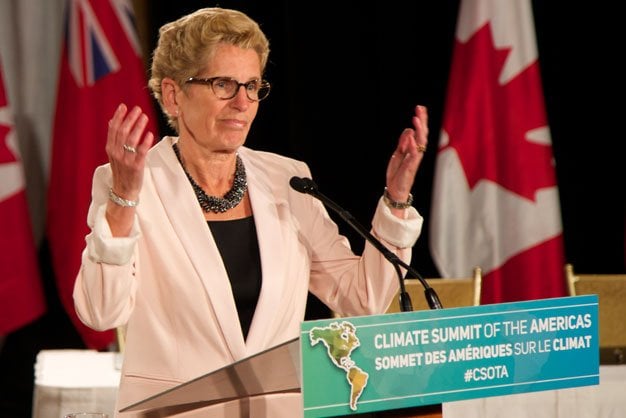
As athletes filed into town for the Pan Am Games, state and provincial politicos from across the Americas gathered at the Fairmont Royal York Hotel last week for their own quasi-athletic event – pole-vaulting over stalled plans to get their respective national governments moving on climate change.
While the race is on to settle on a plan to slash greenhouse gases and rescue at December’s COP21 in Paris, most national governments are still squabbling over how to tie their shoelaces. A growing number of sub-national governments are linking arms to sidestep that whole quagmire.
Rammed with presidents, ex-veeps, sitting governors, premiers, MPs, MPPs as well as a handful of indigenous reps and enviro orgs, the Climate Summit Of The Americas (July 7-9) called on provinces, states and municipalities not just to “light a fire” under national governments, as California governor Jerry Brown put it, but to “fill the void,” as Quebec preem Philippe Couillard said.
Day one Cameras flash as Brown, Couillard and Premier Wynne talk up their freshly expanded cap-and-trade coalition at a press conference. Brown’s home state has seen the most crippling extreme weather. When NOW asks if governments are doing enough to prevent runaway climate change, he’s frank: “No, we’re not doing enough – that’s clear. We’re just barely taking baby steps, and many countries aren’t even doing that. I hope we have enough time, but we certainly have to make a radical, systematic, continuous effort on a local, national and global basis.”
Brown concedes that the Pope may have been right that cap-and-trade “on its own” isn’t radical enough to bring about the change we need, but the governor says its part of an action plan that, in Cali at least, includes cutting petroleum use by 50 per cent, generating 50 per cent more electricity from renewables and improving the energy efficiency of old buildings (the strategy known as 50/50/50). All within 15 years.
Ontario doesn’t yet have the same ambitious 50/50/50 plan, but enviros hope all this sub-national chumming around will inspire us to follow suit. Though Ontario will tell you it’s ahead of Cali on the greenhouse gas reduction front, the province’s environment commissioner says we’re behind on our 2020 targets.
Either way, we’re all supposed to be gunning to drop per capita emissions to an über-trim 2 tonnes by 2050 to keep us under 2°C warming, according to one major sub-national agreement, the Under 2 MoU (Memorandum of Understanding). Quebec signed on at the summit, joining Ontario, Cali and 16 other states on four continents (collectively representing what would be the world’s third-largest economy). Clearly, we’ve all got work to do.
Day two Former U.S. vice-president Al Gore stirs the summit crowd, reminding us that “we must change, we can change, but will we change? That’s a question this gathering is intended to answer.”
He tells us to “be of good cheer,” and that “the Stone Age didn’t end because they ran out of stones” and that “after the final ‘no’ comes a ‘yes.'”
Then it’s time for another photo-op as Ontario joins officials from 22 other states and regions throughout the Americas to sign the first-ever pan-American statement on climate action.
On paper, that commitment is pretty noncommittal, encouraging signatories to pick one or more general actions: GHG reductions that help keep global temps below a 2°C increase, sign on to the Compact Of States And Regions and Compact Of Mayors to publicly report on emission reductions, and/or put a price on carbon, and/or commit to join the Under 2 MoU.
All those and/ors make it pretty “notional,” Environmental Defence’s Tim Gray says during a coffee break.
“But what an event like this does is help to build the credibility of the momentum coming up from the public around the need to move.”
Still, he adds, with only a couple provinces leading the charge, “You run the risk of all the positive things being achieved here being washed away by the expansion of the tar sands.”
Greenpeace’s Keith Stewart says it’s nice to see politicians talking like activists about the real price of inaction and making genuine moves like phasing out coal and putting a price on carbon.
But the real test to see if Ontario means what it’s saying on climate action, says Stewart, will come this week, when the province will be asked to sign on to a national energy strategy that puts pipelines and tar sands expansion ahead of building a new energy economy. And again in the fall when it finalizes its cap-and-trade system.
So far it looks like the premiers’ national energy strategy will be fast-tracking pipelines and leaving absolute targets on greenhouse gas reductions on the back burner. Truth is, without an aggressive climate champ in the PMOs office, we shouldn’t be surprised. Particularly when one new premier, Alberta’s Rachel Notley, told a business crowd in Calgary last week that she’s pushing ahead with oil sands expansion.
It’s certainly clear from the climate summit that federal cabinet ministers would rather stick to the corporate-sponsored Global Toronto Forum on the economy happening just across the hall.
Without the feds on board, sub-nationals may be our only kick at the can.
Hopefully, Ontario Minister of the Environment and Climate Change Glen Murray is right. Maybe a coalition of international sub-nats that “make up a large part of the world’s economy could do what the UN framework on climate change process hasn’t been able to do so far.”
Now we’ve just got to stay on top of our sub-nats to make sure they get it right. As Brown says, “The stakes couldn’t be higher, and the hour is very late.”
adriav@nowtoronto.com | @ecoholicnation












